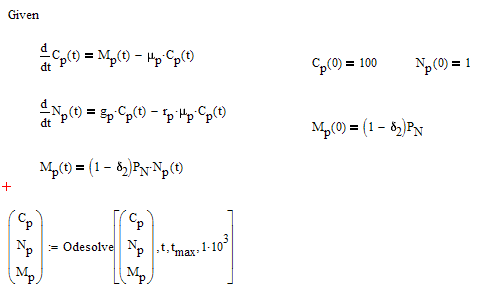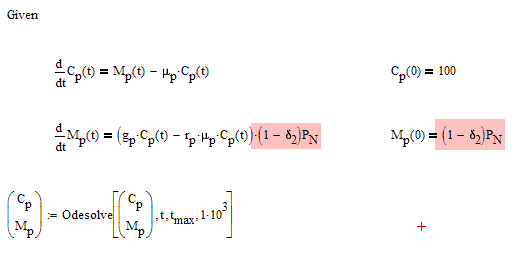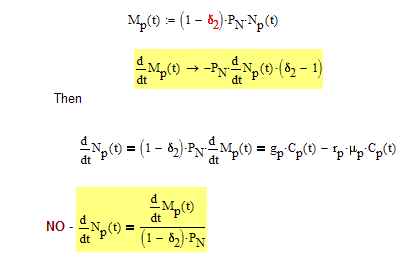Community Tip - Did you know you can set a signature that will be added to all your posts? Set it here! X
- Subscribe to RSS Feed
- Mark Topic as New
- Mark Topic as Read
- Float this Topic for Current User
- Bookmark
- Subscribe
- Mute
- Printer Friendly Page
ODE solve help : predefine a function
- Mark as New
- Bookmark
- Subscribe
- Mute
- Subscribe to RSS Feed
- Permalink
- Notify Moderator
ODE solve help : predefine a function
Hi,
It would be super great to have any suggestions for the mathcad file I have attached.. Please check the file, I have described it there..
Thanks!
- Labels:
-
Calculus_Derivatives
- Mark as New
- Bookmark
- Subscribe
- Mute
- Subscribe to RSS Feed
- Permalink
- Notify Moderator
Not sure if I understand correctly what you want to achieve,
I wonder why you would want to introduce a third unknown function in the solve block which is dependent in a simple way on the function N.p which you are solving for.
Are you looking for something like this:

- Mark as New
- Bookmark
- Subscribe
- Mute
- Subscribe to RSS Feed
- Permalink
- Notify Moderator
- Mark as New
- Bookmark
- Subscribe
- Mute
- Subscribe to RSS Feed
- Permalink
- Notify Moderator
I guess the initial value of M.p should not be 1 but 30 ((1-delta2)*P.N.)
But I wonder why the result is so much different!?
EDIT: I felt into the same trapdoor. It should rather be like this:

- Mark as New
- Bookmark
- Subscribe
- Mute
- Subscribe to RSS Feed
- Permalink
- Notify Moderator
i think the picture is not attached well.. I cannot see it..
- Mark as New
- Bookmark
- Subscribe
- Mute
- Subscribe to RSS Feed
- Permalink
- Notify Moderator
preeti baskaran wrote:
i think the picture is not attached well.. I cannot see it..
This unfortunately happens ever so often.
Hope it works this time:

- Mark as New
- Bookmark
- Subscribe
- Mute
- Subscribe to RSS Feed
- Permalink
- Notify Moderator
Hi,
I think it is getting a bit deviated from i want to achieve.. I don't want to add an extra M.p on the ODE block, I am only trying to simplify my equations.
What i trying to achieve is to make the C.p(t) equation look a bit simple by shrinking ((1-delta2)*P.N' N.p(t)) into one variable such as M.p(t).
such as to predefine a variable,
M.p(t) = (1-delta).P.N*N.p(t)
So that,
C.p(t) = M.p(t) - µ.pCp(t)
or if this is possible?
- Mark as New
- Bookmark
- Subscribe
- Mute
- Subscribe to RSS Feed
- Permalink
- Notify Moderator
Look at Fred's post and the picture I just posted a second time.
Or maybe the second pic in my first replay, if you still want to solve for N.p and not M.p.
- Mark as New
- Bookmark
- Subscribe
- Mute
- Subscribe to RSS Feed
- Permalink
- Notify Moderator
But.. did u read the post that i replied recently?
I wonder why you would want to introduce a third unknown function in the solve block which is dependent in a simple way on the function N.p which you are solving for.
Are you looking for something like this:
I dont want to introduce a third unknown function, I would just like to simplify my equations by predefining them
- Mark as New
- Bookmark
- Subscribe
- Mute
- Subscribe to RSS Feed
- Permalink
- Notify Moderator
Go read the sheet I posted.
You can do a simple modification of your solve block allows M (t) instead of N (t). There is some question about boundary conditions.
- Mark as New
- Bookmark
- Subscribe
- Mute
- Subscribe to RSS Feed
- Permalink
- Notify Moderator
Fred Kohlhepp wrote:
Go read the sheet I posted.
You can do a simple modification of your solve block allows M (t) instead of N (t). There is some question about boundary conditions.
I still think that your equation is wrong. You should not divide by (a-delta2)*P.N but multiply - see here: http://communities.ptc.com/message/261074#261074
- Mark as New
- Bookmark
- Subscribe
- Mute
- Subscribe to RSS Feed
- Permalink
- Notify Moderator
Werner Exinger wrote:
I still think that your equation is wrong. You should not divide by (a-delta2)*P.N but multiply - see here: http://communities.ptc.com/message/261074#261074
Werner;
Attached is my logic. Show me!
- Mark as New
- Bookmark
- Subscribe
- Mute
- Subscribe to RSS Feed
- Permalink
- Notify Moderator
Fred Kohlhepp wrote:
Werner Exinger wrote:
I still think that your equation is wrong. You should not divide by (a-delta2)*P.N but multiply - see here: http://communities.ptc.com/message/261074#261074
Werner;
Attached is my logic. Show me!
Her is mine

- Mark as New
- Bookmark
- Subscribe
- Mute
- Subscribe to RSS Feed
- Permalink
- Notify Moderator
You're right!!
Don't know where my head was at.
- Mark as New
- Bookmark
- Subscribe
- Mute
- Subscribe to RSS Feed
- Permalink
- Notify Moderator
Thanks and I appreciate your valuable solutions.. but I feel its is only making the equations complicated...
- Mark as New
- Bookmark
- Subscribe
- Mute
- Subscribe to RSS Feed
- Permalink
- Notify Moderator
preeti baskaran wrote:
Thanks and I appreciate your valuable solutions.. but I feel its is only making the equations complicated...
It's not making it complicated; it's doing what you asked--replacing Np(t) with Mp(t)
You can combine these two equations into a single second order ODE in Cp, and solve it via Laplace transfer. For the parameters values you gave, you get the same solution.
I'm done.
- Mark as New
- Bookmark
- Subscribe
- Mute
- Subscribe to RSS Feed
- Permalink
- Notify Moderator
Attached is another analytical solution, together with the resulting numerical values using your input data (some of the numerical constants are slightly different from Fred's).
Alan
PS Are you sure you've got the all the signs right?
- Mark as New
- Bookmark
- Subscribe
- Mute
- Subscribe to RSS Feed
- Permalink
- Notify Moderator
preeti baskaran wrote:
But.. did u read the post that i replied recently?
I wonder why you would want to introduce a third unknown function in the solve block which is dependent in a simple way on the function N.p which you are solving for.
Are you looking for something like this:
I dont want to introduce a third unknown function, I would just like to simplify my equations by predefining them
Yes, I read your reply - did you read ours? Neither my second approach in my first reply nor Fred's approach uses a third unknown function. The choice is if you will use your M.p instead of N.p (and so also solve vor M.p) and use Freds approach or if you like to use M.p as an abbrevation but still want to solve for N.p - then my second approach (where M.p is dependent on t AND N.p(t)) may help.





